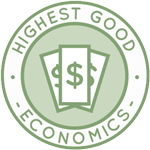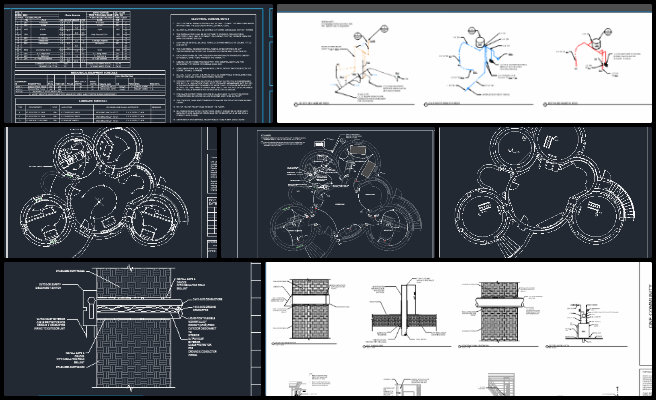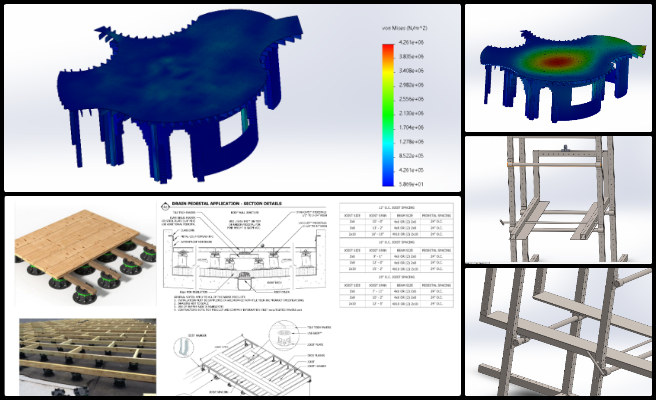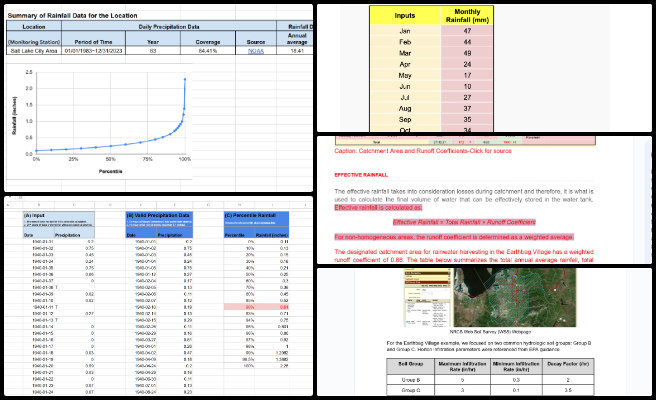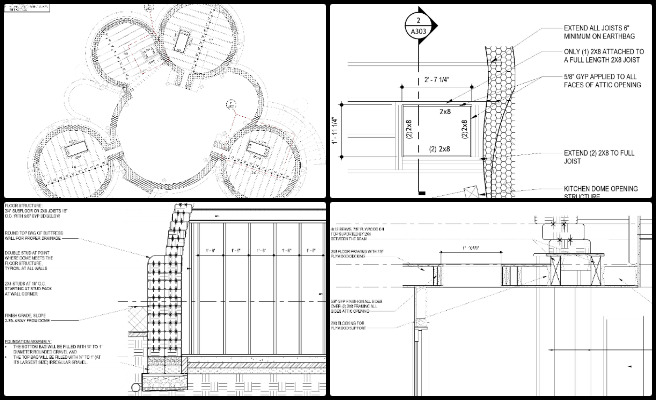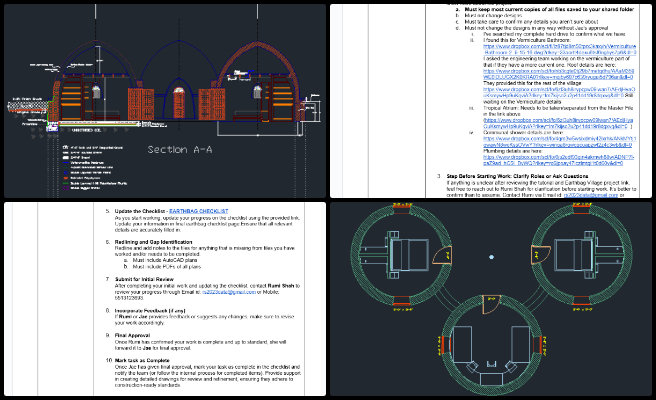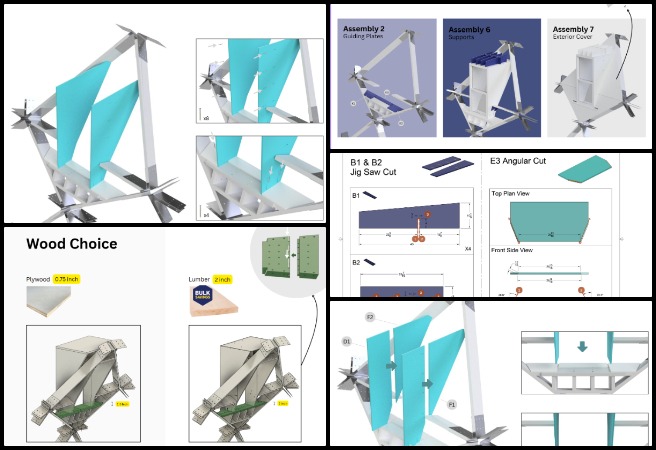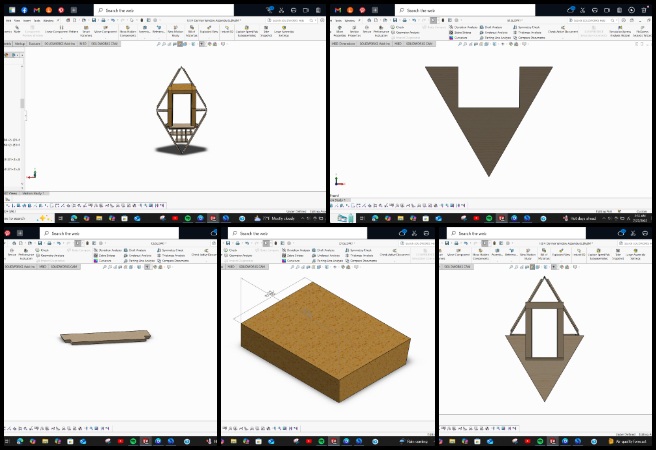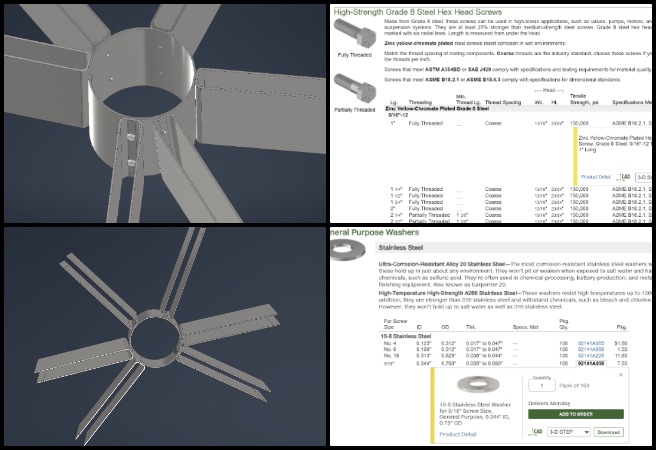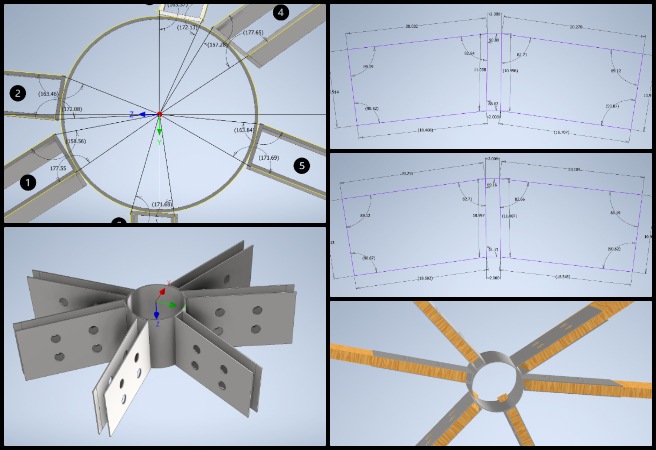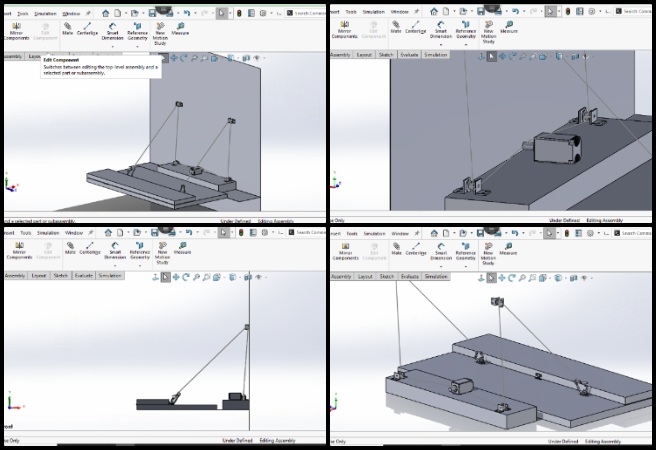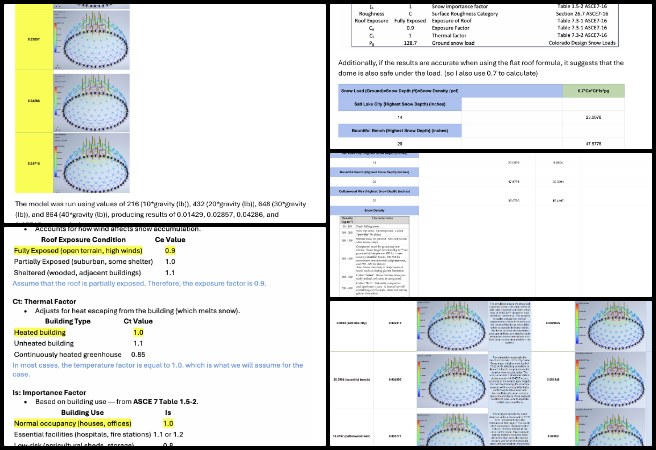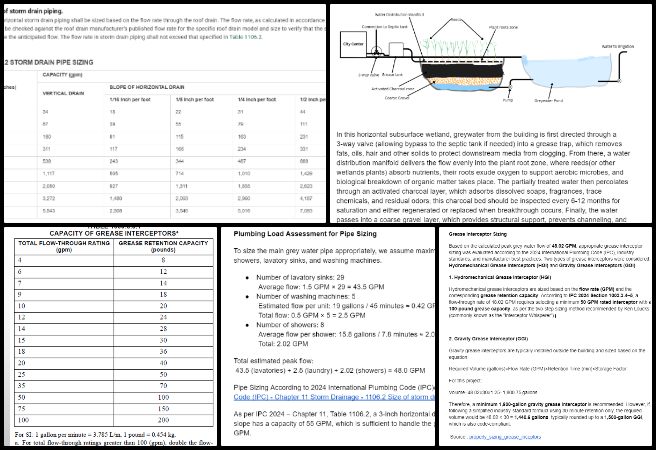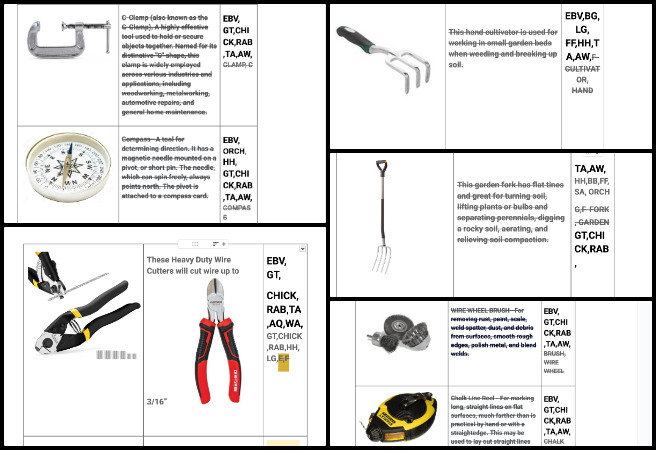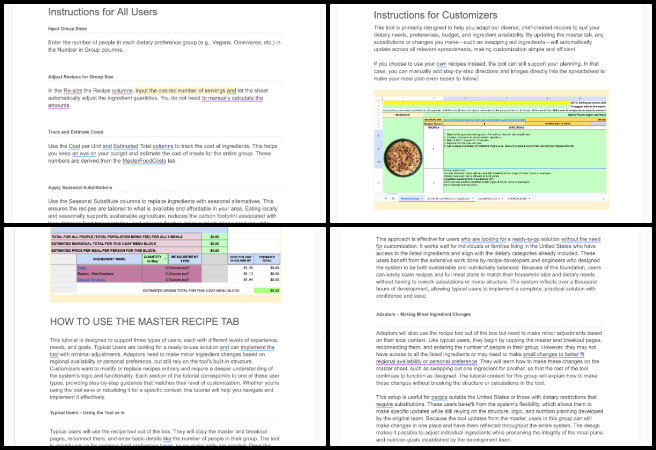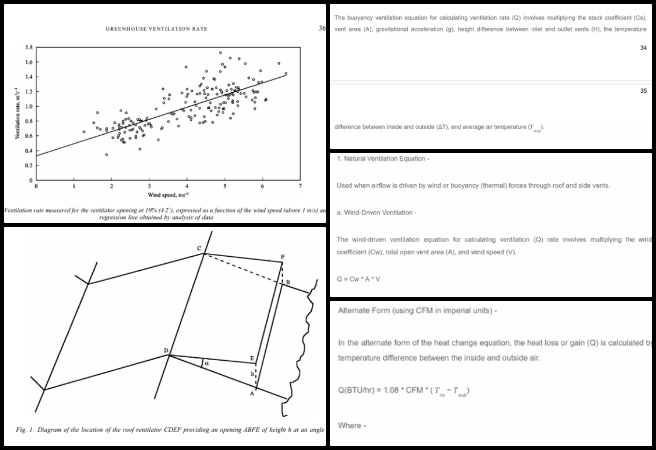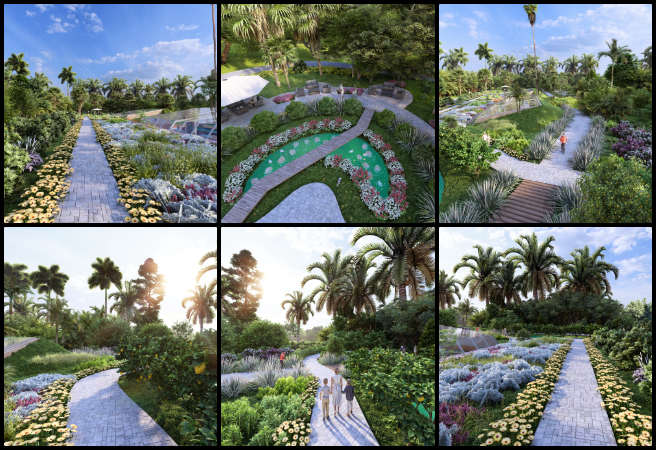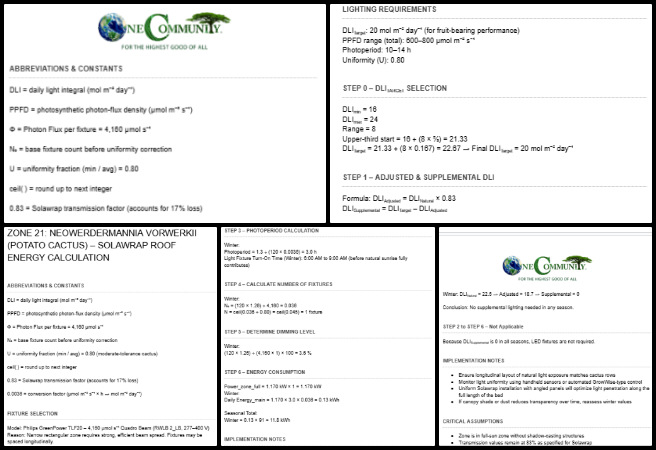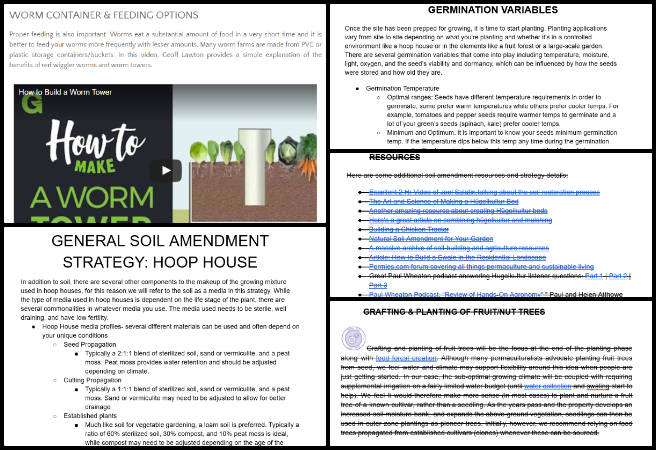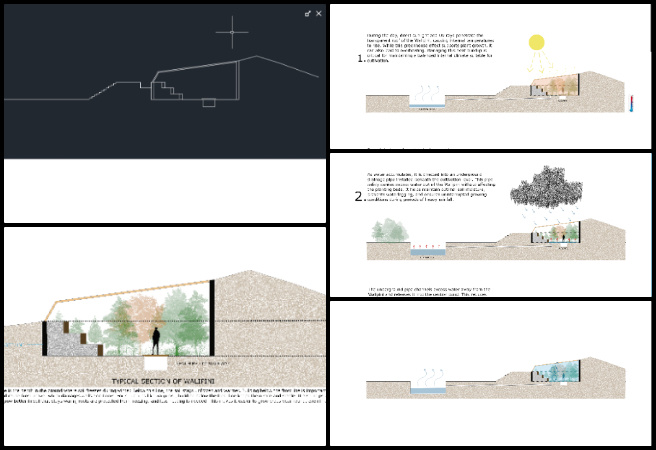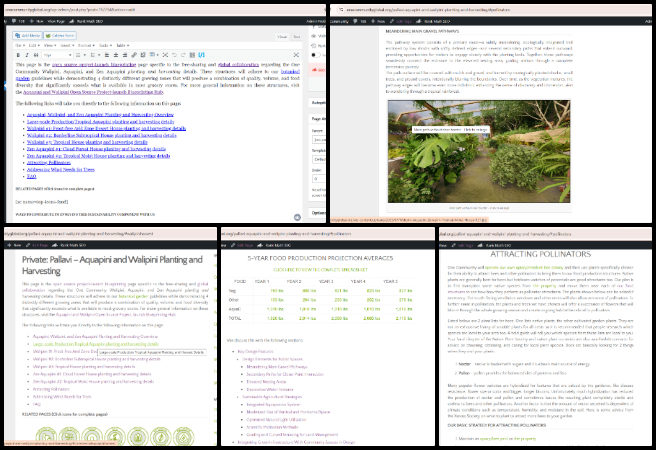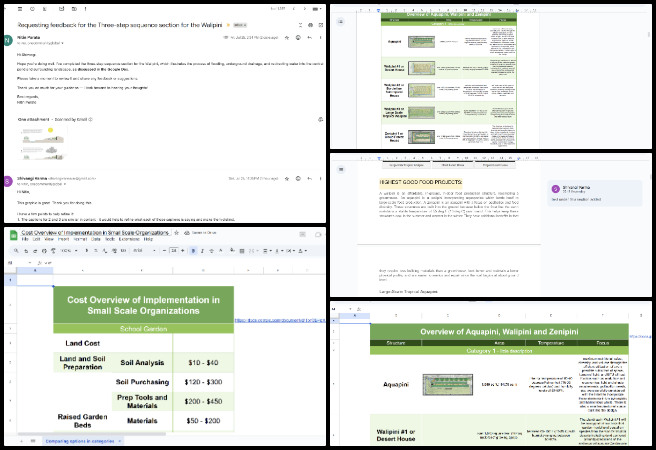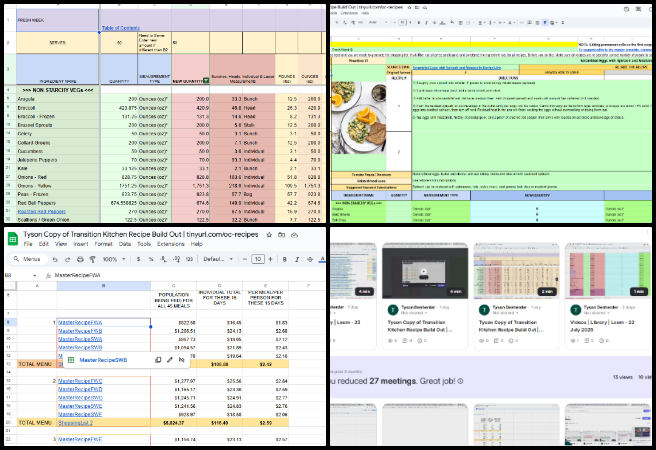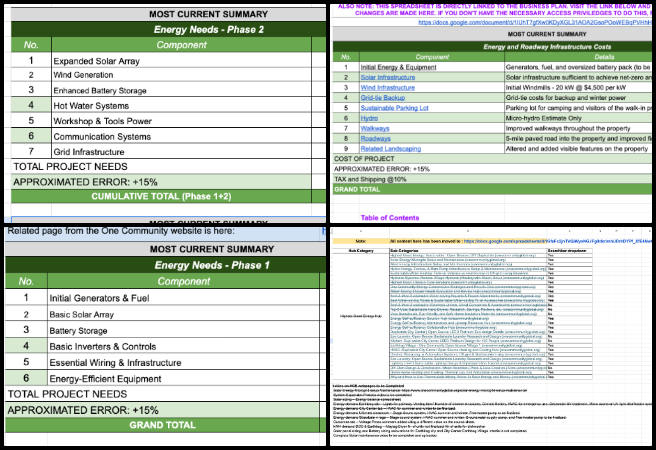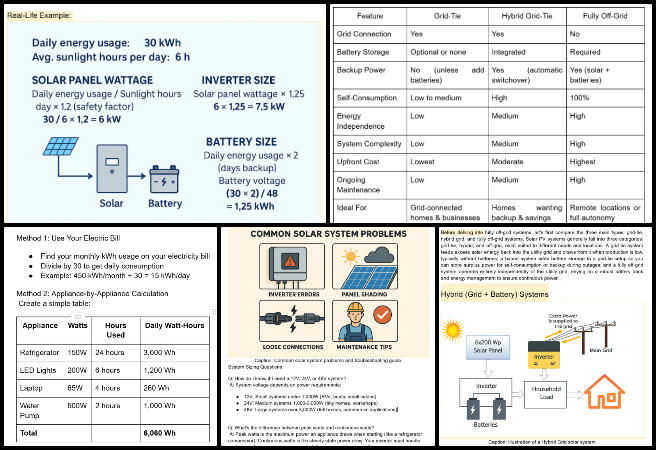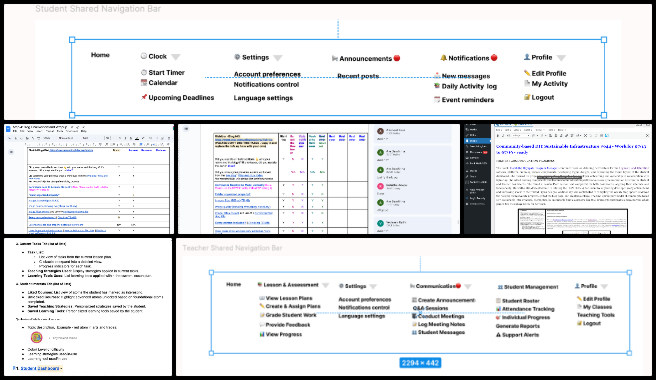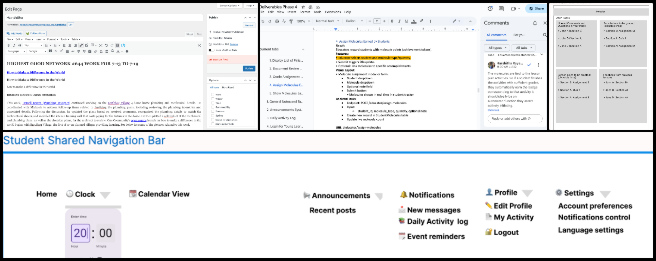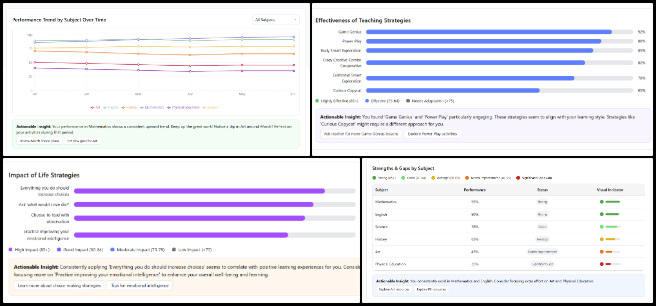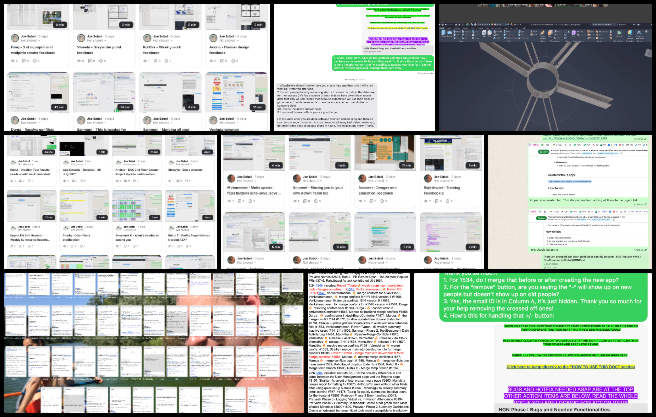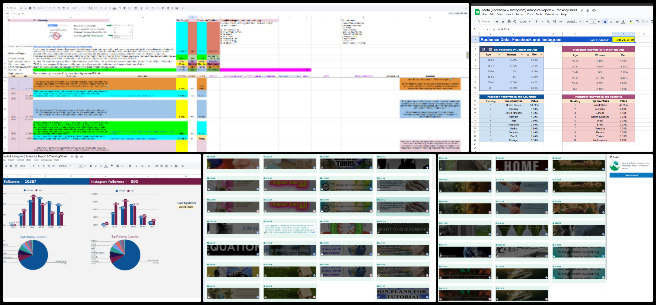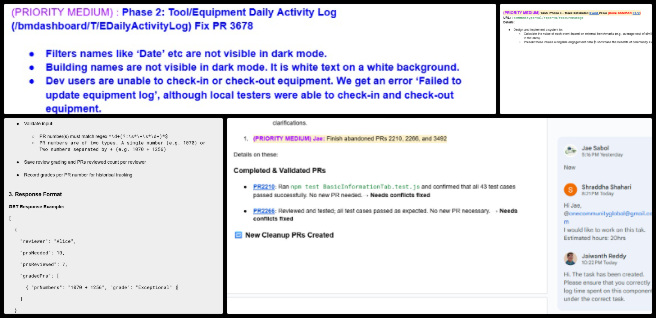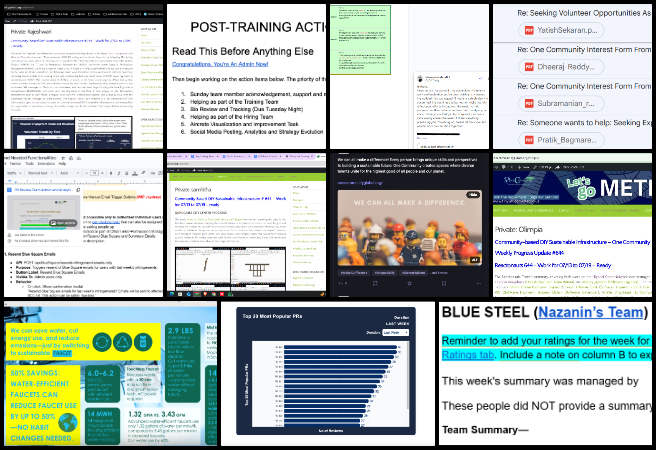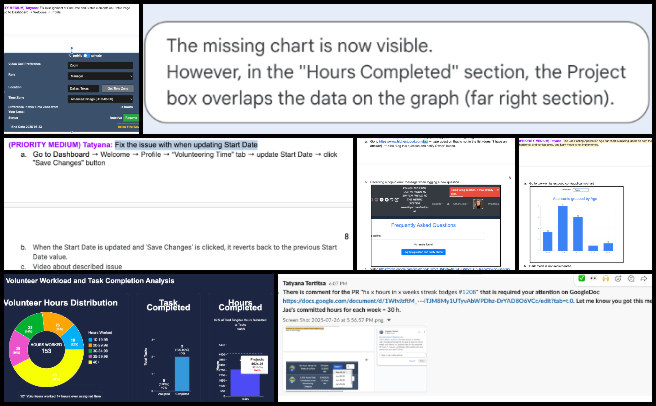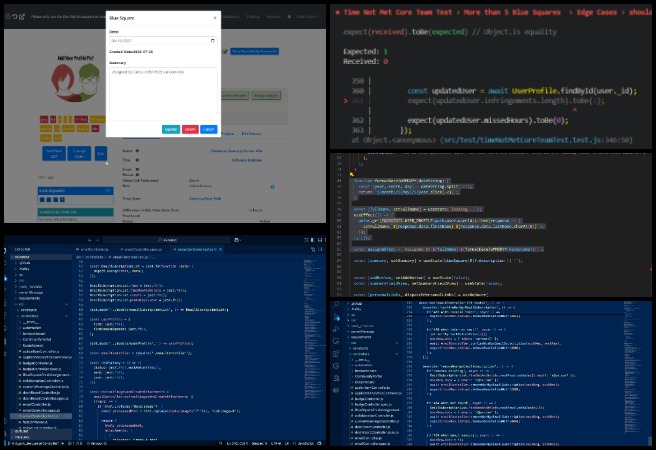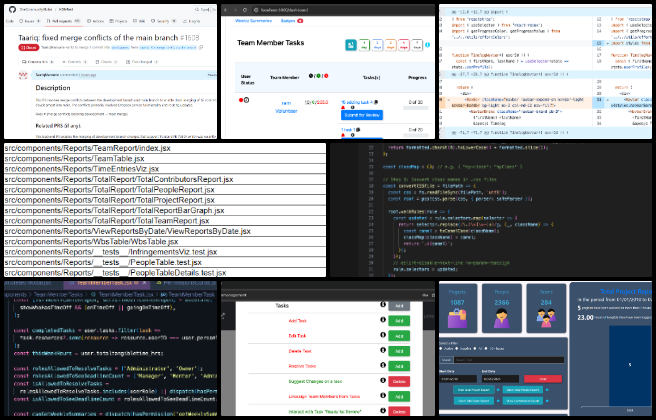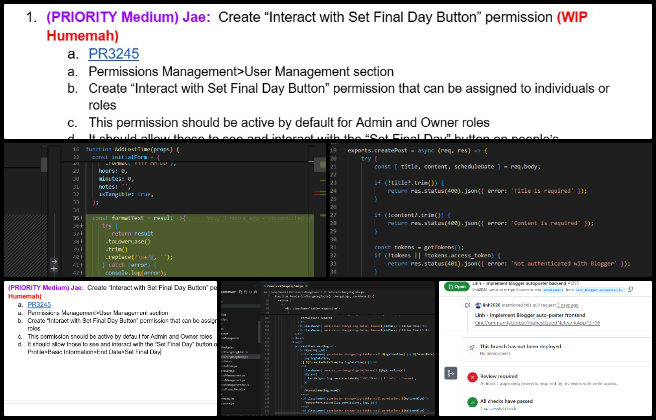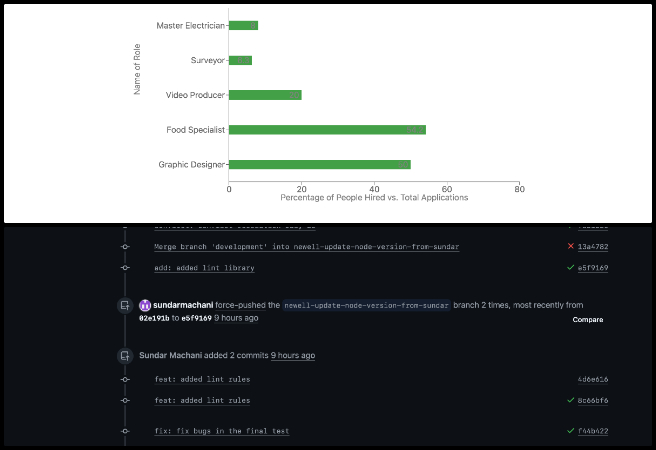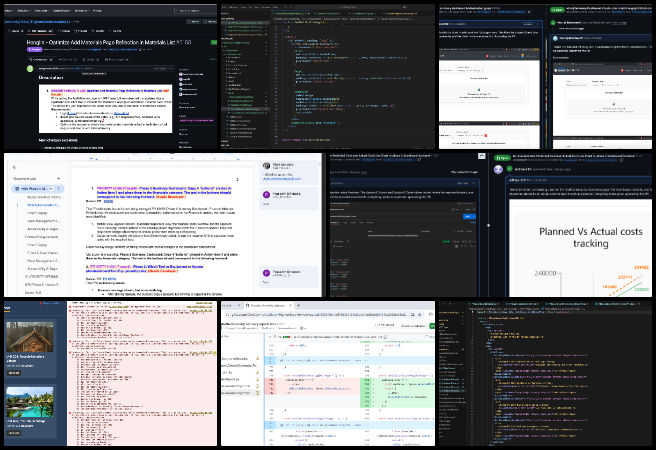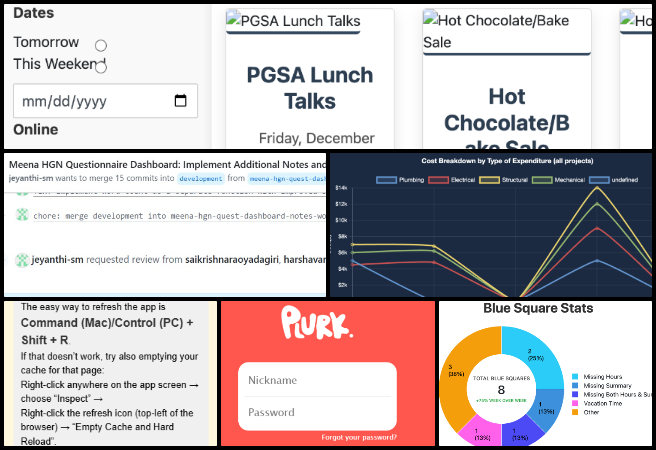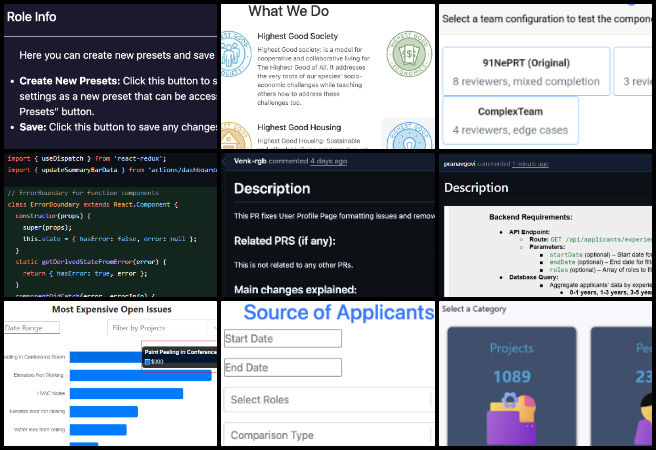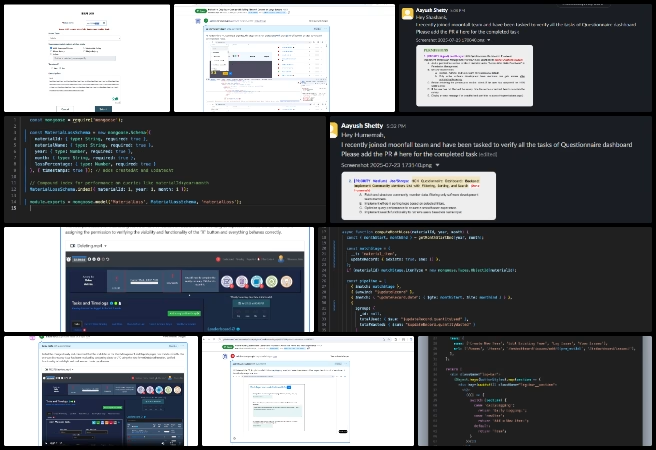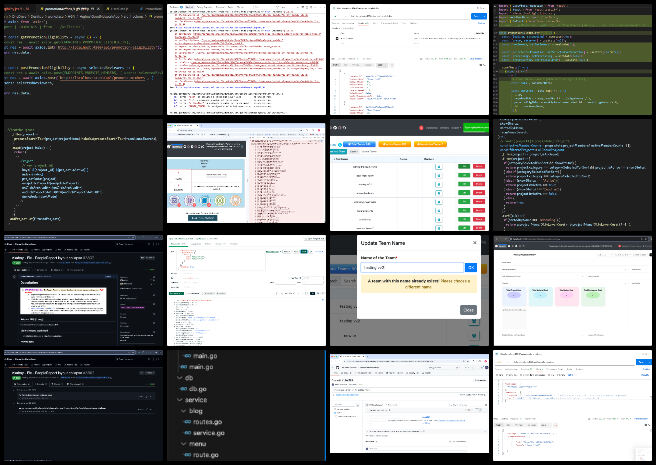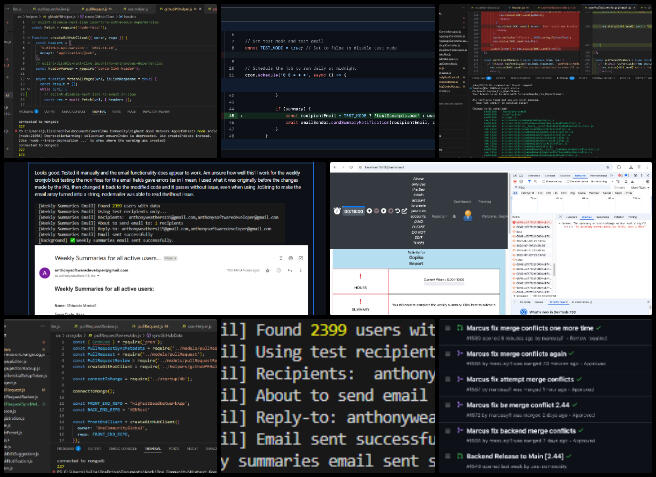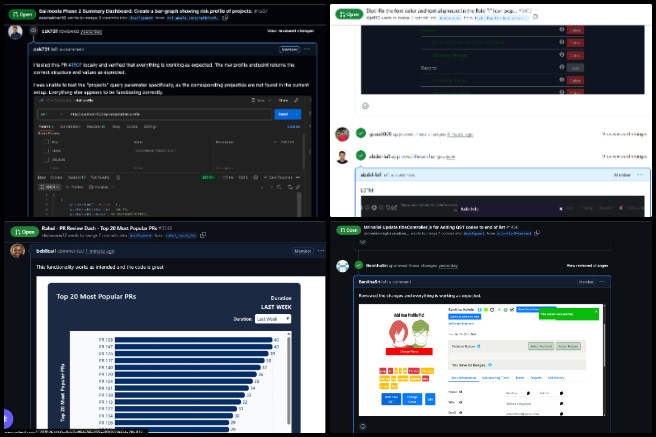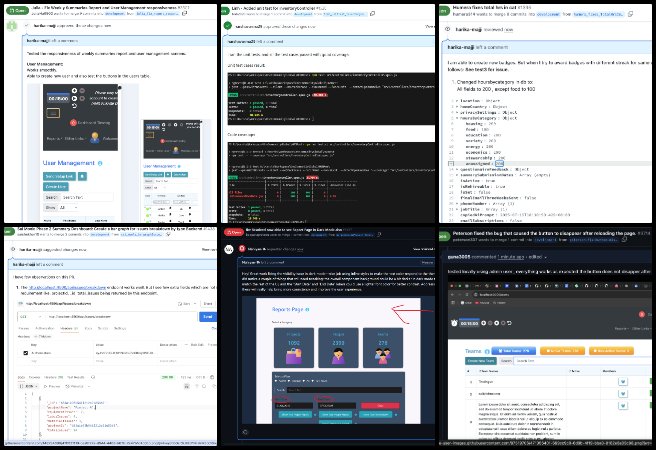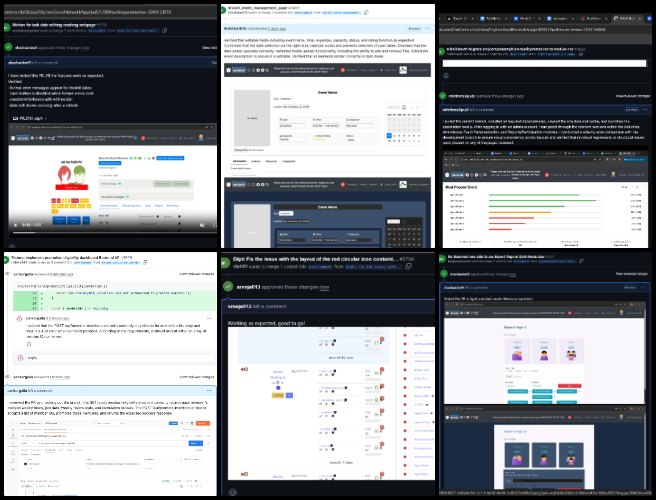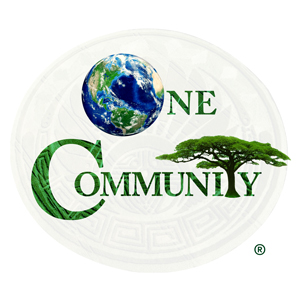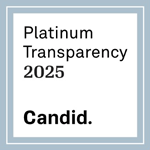How to Make a Difference in the World – One Community Weekly Progress Update #645
At One Community, we are modeling how to make a difference in the world by open sourcing and free sharing sustainable solutions for food, energy, housing, education, economics, social architecture, fulfilled living, global stewardship practices, and more. Created by an all-volunteer team, our work is designed to be self-replicating and support the development of teacher/demonstration hubs around the globe. In doing so, we’re turning inspired ideas into real-world action—evolving sustainability and paving the way for a more sustainable and equitable future for all, in alignment with the values of The Highest Good of All.
- Here’s our project overview
- Here’s our world-change methodology
- Here’s how this becomes self-replicating
- Here’s how we are open source and free-sharing all the do-it-yourself designs
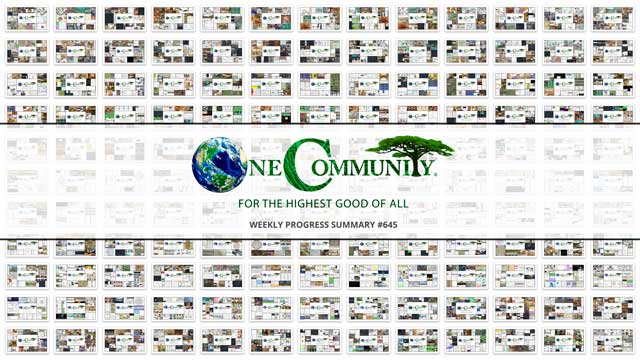
OUR MAIN OPEN SOURCE HUBS
Click on each icon to be taken to the corresponding Highest Good hub page.
One Community’s physical location will forward this movement as the first of many self-replicating teacher/demonstration communities, villages, and cities to be built around the world. This is the July 28, 2025 edition (#645) of our weekly progress update detailing our team’s development and accomplishments:
How to Make a Difference in the World
One Community Progress Update #645
DONATE | COLLABORATE | HELP WITH LARGE-SCALE FUNDING
CLICK HERE IF YOU’D LIKE TO RECEIVE AN EMAIL EACH WEEK WHEN WE RELEASE A NEW UPDATE
YOU CAN ALSO JOIN US THROUGH SOCIAL MEDIA
ONE COMMUNITY WEEKLY UPDATE DETAILS
HIGHEST GOOD HOUSING PROGRESS
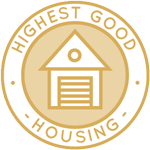 One Community is modeling how to make a difference in the world through Highest Good housing that is artistic and beautiful, more affordable, more space efficient, lasts longer, DIY buildable, and constructed with healthy and sustainable materials:
One Community is modeling how to make a difference in the world through Highest Good housing that is artistic and beautiful, more affordable, more space efficient, lasts longer, DIY buildable, and constructed with healthy and sustainable materials:
- Learn about: Our Upcoming Crowdfunding Campaign
- Learn about the different village models: 7 Sustainable Village Models
- Visit the open source portals for the first two: Earthbag Village OS Hub | Straw Bale Village OS Hub
This week, Derrell Brown (Plumbing Designer) continued working on the Earthbag Village 4-dome home plumbing and electrical plans details. He coordinated with Michaela to address follow-up items related to finalizing the designs, including reviewing the plumbing isometric drawings, relevant details, and previous electrical layouts. He revised the plans based on feedback received, updated the plumbing details to reflect requested changes, and made minor adjustments to the latest electrical layout. Derrell then generated a colored set of the mechanical, plumbing, and electrical plans for the architect to review. One Community’s open source launch on how to make a difference in the world begins with Earthbag Village, the first of seven planned villages providing housing. See below for some of the pictures related to this work.
Karthik Pillai (Mechanical Engineer) continued working on the Earthbag Village 4-dome cluster roof project. He updated the FEA analysis by integrating revised live load calculations into the structural model. The simulation produced updated stress and strain results, which were shared with Michaela and uploaded to Dropbox for documentation and collaboration. The existing report was also reviewed to begin incorporating changes reflecting the new load conditions. In parallel, for the vermiculture toilet project, Karthik conducted a design review and identified necessary changes to the waste dumping mechanism. He also made updates to the corresponding project report to align it with the most recent design changes. As the first of seven planned villages, the Earthbag Village provides the initial housing within One Community’s open source designs on how to make a difference in the world. Shown below are some photos highlighting this work.
Ketsia Kayembe (Civil Engineer) continued worked on the three domes of the Earthbag Village. She focused on reviewing Yi-Ju’s work, including the LEED tutorial related to the Earthbag Village, while waiting to regain access to AutoCAD. After completing the review, Ketsia began gathering the necessary information and resources to write and organize the Earthbag Village content to reflect the updated stormwater management design and its alignment with LEED evaluation. One Community’s open source framework on how to make a difference in the world begins with Earthbag Village, the first of seven planned villages providing housing. See below for some of the pictures related to this work.
Michaela Silva (Architect) continued fine-tuning details in the construction documents of the Earthbag Village. She modeled the kitchen attic framing using 2×8 joists and added framing around the attic opening. Michaela created an enlarged plan detail of the attic opening condition and drew a section through the attic hatch to show its location relative to the kitchen dome opening structure. She also drew a section through the plumbing wall to illustrate how the framing aligns with the dome curvature. The Earthbag Village is the first of seven villages to be built as part of One Community’s open source model on how to make a difference in the world. See her work in the collage below.
Rumi Shah (Civil Engineer) continued working on the Earthbag Village. Updates were made to the project document, and work progressed on three dome cluster sections, including editing content and adjusting structural details. Rumi also prepared the template source file to improve consistency and alignment with project standards across related documentation and future deliverables. One Community’s open source resources on how to make a difference in the world begin with the Earthbag Village, the first of seven planned villages providing housing. Take a look at the following images related to this project.
DUPLICABLE CITY CENTER PROGRESS
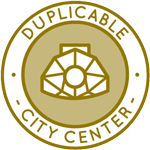 One Community is modeling how to make a difference in the world through a Duplicable and Sustainable City Center that is LEED Platinum certified/Sustainable, can feed 200 people at a time, provide laundry for over 300 people, is beautiful, spacious, and saves resources, money, and space:
One Community is modeling how to make a difference in the world through a Duplicable and Sustainable City Center that is LEED Platinum certified/Sustainable, can feed 200 people at a time, provide laundry for over 300 people, is beautiful, spacious, and saves resources, money, and space:
- Learn about this building and it’s function: Duplicable City Center Open Source Hub
This week, Andrew Chen (Industrial Designer) continued work on the Dormer second-floor window for the Duplicable City Center. He updated the cut sheet units and measurements based on Jae’s feedback and added cut numbers and directional annotations to clarify the cutting instructions. Andrew also refined the instruction slides to improve visual communication and layout. The Duplicable City Center showcases One Community’s open-source approach to how to make a difference in the world. The images below illustrate aspects of this work.
Ariana Virginia Gutierrez Doria Medina (Industrial Designer) continued the analysis and cost estimation of the windows for the Duplicable City Center. She focused on redrawing parts to eliminate the use of glue and reduce cutting efforts, aligning with sustainable building principles. The team worked on the final details of the new assembly using components that were redrawn to avoid unnecessary cuts and reduce glued parts. Work also began on the assembly instructions to organize the parts and identify which components require detailed attention for cutting and cost considerations. Explore how One Community’s open-source Duplicable City Center empowers people to learn how to make a difference in the world. Browse the visuals below.
Ayushman Dutta (Mechanical Engineer) continued working on reviewing pipe materials for the Duplicable City Center hub connector design. Ayushman also analyzed the dome hub connector to determine the lowest angles across all rows, supporting the goals of sustainable future building. He worked on the CAD design of the spokes by altering their dimensions and verifying proper flush fit within the hub connector pipe. Ayushman focused on spoke design and tolerance checking to establish the required angles for an accurate fit. He attended the weekly team meeting to discuss current progress, design roadblocks, and next action items. Ayushman also integrated the new hub connector design into the dome assembly to prepare the model for FEA analysis and stress evaluation. He prepared the CAD file for FEA analysis and worked on assembling the hub connector within the existing dome structure. During assembly, he encountered some issues and collaborated with Nupur and Nikhil to resolve these technical challenges and advance the stress analysis phase. Through open-source design, the Duplicable City Center teaches how to make a difference in the world. Here are several visuals that relate to this work.
Nikhil Bharadwaj (Mechanical Engineer) continued working on creating the spoke designs for the Duplicable City Center hub connector. During the design of row 2 spokes, an interference issue was identified between spokes during assembly. He used the final hub connector design for row 2 to replace the manufactured component in the dome assembly and discovered conflicts with existing beams due to the larger hub size. This required shortening beam lengths to accommodate the updated design. In parallel, Nikhil created drawings for the spokes to be included in the assembly document, supporting the process of cutting the spokes from metal sheets. One Community’s Duplicable City Center is an open-source example of how to make a difference in the world. Here are a few pictures that showcase this work.
Sandesh Kumawat (Mechanical Engineer) continued working on the City Center Natural Pool and Eco-spa Designs. He developed a new folding mechanism in response to managerial feedback that the previous iteration could result in excessive losses. Sandesh built on his previous work—starting with the four-bar linkage praised for its simplicity, moving through slot-guided and slide-and-fold variants, refining timing-belt pulley sequences, and testing a curved-rail prototype—and refined the belt-driven folding mechanism by optimizing pulley placement and adding spring-loaded idler wheels to maintain tension around compact hinge pivots. He adjusted pulley diameters and flanged guard profiles to prevent belt slip and interference, then began finite element analysis (FEA) on the link arms, pulley mounts, and plate sections to verify load capacity and identify stress points under operational conditions. All updated CAD models and simulation outputs have been uploaded to the shared Dropbox folder for review. Discover how to make a difference in the world through One Community’s open-source Duplicable City Center. View the images below.
Srujan Pandya (Mechanical Engineer) continued helping with the Duplicable City Center FEA analysis. He reviewed Shu’s feedback and extracted key points to prepare for an upcoming discussion with Dipak regarding the potential need for re-analyzing the snow load data—an important consideration in sustainable future building. Srujan followed up with Shu to request all relevant files, including load calculations, the associated write-up, and the latest results. The received load calculation results were reviewed and prepared for verification using the vertical model configured for snow load conditions. The vertical model was set up to match Shu’s assumptions in order to validate the consistency of the load data. Once the results were confirmed to align, Srujan proceeded to run structural analysis using the input data. Work progressed on compiling scenario-specific outputs based on the validated model results. The Duplicable City Center demonstrates how open-source can guide people in how to make a difference in the world. The images below illustrate aspects of this work.
Vineela Reddy Pippera Badguna (Mechanical Engineer) conducted in-depth research on greywater reuse systems for the Duplicable City Center as part of ongoing efforts to make a difference in the world. She compiled research into a Google Document for feedback, added a detailed sketch of the greywater treatment process using Canva, and updated the document to include the proposed treatment system with cross-verified details. Vineela reviewed a website for a better understanding of wetlands and their application in treatment systems. She also researched appropriate pipe sizing for greywater and performed the necessary calculations. Additionally, she calculated the required size for a grease interceptor based on usage estimates and regulatory guidelines. This open-source Duplicable City Center project shows how to make a difference in the world through sustainable design. See below for some of the pictures related to this work.
HIGHEST GOOD FOOD PROGRESS
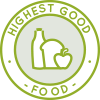 One Community is modeling how to make a difference in the world through Highest Good food that is more diverse, more nutritious, locally grown and sustainable, and part of our open source botanical garden model to support and share bio-diversity:
One Community is modeling how to make a difference in the world through Highest Good food that is more diverse, more nutritious, locally grown and sustainable, and part of our open source botanical garden model to support and share bio-diversity:
- Learn about the structures: Hoop House Hub | Aquapini & Walipini Open Source Hub
- See what we’ll be growing: Gardens & Hoop Houses | Large-scale Structures | Food Forest | TA
This week, the core team continued their review of the Master Tools, Equipment, and Materials/Supplies list. They added acronyms to the specific project lists where these items will be utilized. Corrections were made, replacing outdated acronyms with proper ones, and commas were inserted through page 159 to improve clarity and support the addition of TEMS for specific project searches. These corrections and additions have been completed through page 191 of the 266-page document. The Highest Good Food initiative is a key component of One Community’s open source plans, focused on how to make a difference in the world, and exemplifies the organization’s commitment through innovative design and implementation. Shown below are some photos highlighting this work.
Chelsea Mariah Stellmach (Project Manager) continued her work on the Transition Food Self-sufficiency Plan menus and customization spreadsheets. She developed user-facing content for the recipe tutorial, including an introductory section outlining three user types Typical Users, Adaptors, and Customizers and how each can navigate the tutorial based on their level of customization. She wrote tailored blurbs describing how each user type interacts with the tool, formatted for consistency, and added explanations of how the system’s structure, built by recipe developers and engineers, allows users to scale recipes and meal plans in a sustainable and nutritious way. She also collaborated with Tyson on improving the functionality of both the spreadsheet tool and the written tutorial. As an essential aspect of One Community’s open source goals, the Highest Good Food initiative supports how to make a difference in the world as a foundation for sustainable living. Below are some of the images showcasing this work.
Dirgh Patel (Volunteer Mechanical Engineer) continued assisting with the Climate Battery design evolutions. He edited the final report by adding clarifying details to the ventilation heat calculation and uploaded related resource PDFs to the shared folder. Dirgh reviewed materials on basic greenhouse engineering calculations, including formulas for heat loss based on surface area, U-values, and temperature differences, as well as fan ventilation and horizontal airflow requirements. He studied ventilation measurement techniques using tracer gas methods, exploring both static and dynamic models and their correlation with environmental factors like wind and vent opening. Additionally, Dirgh improved the report’s Excel formatting and made equation explanations easier to follow by inserting contextual information above the formulas. One Community’s open source mission is powerfully reflected in the Highest Good Food initiative, which is focused on advancing how to make a difference in the world for global benefit. The following visuals highlight key outcomes of this initiative.
Faeq Abu Alya (Architectural Engineer) continued his work on the Earthbag Village. He developed the Southwest and Southeast regions by updating material settings, revising texture maps, and incorporating landscape elements. Faeq created a video covering both regions to prepare for the rendering phase. He adjusted surface finish and reflectance values and enhanced visualizations by capturing images from multiple angles to confirm consistency and detail across views. One Community’s open source launch of how to make a difference in the world begins with Earthbag Village, the first of seven planned villages providing housing. See below for some of the pictures related to this work.
Jay Nair (BIM Designer) continued working on Aquapini and Walipini Planting and Harvesting lighting and HVAC design. Jay focused on updating the lighting energy calculation for Greenhouse Walipini 1 by adjusting values for individual zones to align with the project’s seasonal light requirements. He reviewed the specifications of the selected lighting fixtures and verified that the calculations followed the project team’s standardized format for consistency. The Highest Good Food initiative plays a leading role in One Community’s open source platform, demonstrating how to make a difference in the world through sustainable and participatory development. Below are some of the images showcasing this work.
Keerthi Reddy Gavinolla (Software Developer) continued enhancing the Highest Good Food page by adding content focused on small-business and urban community solutions. She continued working on the Soil Amendment and Initial Off-grid Site Preparation page by editing the document to match the website content. Keerthi ensured consistency in formatting, structure, and wording. She also completed her weekly admin work, updating Blog #644 for the Moonfall, Expressers, and Lucky Star Teams. Built on One Community’s open source foundation, the Highest Good Food initiative is dedicated to how to make a difference in the world, empowering communities through self-sustaining systems. Her contributions are showcased in the collage below.
Nitin Parate (Architect) continued contributing to the Highest Good Food. The week began with a study of Paul Wheaton’s greenhouse concept, exploring how Earth’s stable underground temperatures help regulate internal climate and reduce dependence on external energy inputs. Based on Jae’s feedback, Nitin revised the Walipini section to accommodate larger trees and plants. These changes included increasing planting depth, adjusting internal clearances, and repositioning structural components to maintain thermal efficiency and ensure sufficient light access. A revised section was drafted to include the surrounding landscape and a central pond, illustrating a drainage strategy where excess water is directed from the Walipini to the pond to enhance ecological function. This effort supports One Community’s dedication to how to make a difference in the world. The graphic was updated to show the frost line based on regional soil temperature data, following Shivangi’s suggestion, with a caption clarifying that frost depth varies across the U.S. and is not linked to the sun path. Nitin also created two three-step diagrams: one depicting flood management in the Walipini—water accumulation, redirection through an underground pipe, and discharge into a central pond with further release into the landscape—and another illustrating passive cooling using underground pipes that channel cool air from the pond area into the Walipini. The Highest Good Food initiative plays a leading role in One Community’s open source platform, promoting how to make a difference in the world through sustainable and participatory development. The images below illustrate aspects of this work.
Pallavi Deshmukh (Software Engineer) continued working on adding the new Zenapini 2 content to the Aquapini and Walipini Planting and Harvesting page. She completed two interviews and submitted the required information. Pallavi worked on adding Zenapini #2 content from Silin to the website, relocated previously misplaced data to the appropriate section of the page, and reviewed all images and hyperlinks before submitting the updates for review. She checked the page based on Jae’s feedback and submitted it for further review. Pallavi also created new content for Blog #644 and collaborated with teammates by reviewing their suggestions and incorporating feedback to maintain a consistent and clear final version. In alignment with One Community’s open source objectives, the Highest Good Food project integrates how to make a difference in the world into a larger vision of regenerative living. Her contributions are highlighted in the collage below.
Shivangi Varma (Volunteer Architectural Designer And Planner) continued contributing to the Highest Good Food initiative and worked on completing the Aquapini and Walipini Planting and Harvesting page as well as the Open Source Hub page. Shivangi added content where required, formatted pages, suggested key plans, and incorporated additional sections. She completed the Highest Good Food page by updating the text and formatting the tables based on received comments. Shivangi also continued refining the format, text, and graphics of the Open Source Hub page. She connected with the graphic designer and architect volunteer to discuss the graphics, renders, and drawings to be added across the three pages. The Highest Good Food initiative plays a leading role in One Community’s open source platform, promoting how to make a difference in the world through sustainable and participatory development. Below are some of the images showcasing this work.
Tyson Denherder (Volunteer Pioneer Team Member) continued contributing to the Highest Good Food by reviewing and updating the Transition Kitchen Recipe Build Out Tool. The tool now functions correctly when users adjust dietary preferences and population size. All links were fixed, errors in ingredient quantities were corrected, and the shopping lists were modified to reflect the appropriate needs of each group. The Highest Good Food initiative plays a leading role in One Community’s open source platform, promoting how to make a difference in the world through sustainable and participatory development. Take a look at the following images related to this project.
HIGHEST GOOD ENERGY PROGRESS
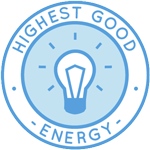 One Community is modeling how to make a difference in the world through Highest Good energy that is more sustainable, resilient, supports self-sufficiency and includes solar, wind, hydro and more:
One Community is modeling how to make a difference in the world through Highest Good energy that is more sustainable, resilient, supports self-sufficiency and includes solar, wind, hydro and more:
- Learn about the open source sustainable-energy foundations: Solar, Hydro, and Wind
- Explore our research into the most sustainable products and companies for saving water and energy: Insulation, Eco-laundry, Lightbulbs and Light Bulb Companies, Doors and Door Companies, Windows and Window Companies, Toilets, Faucets and Faucet Accessories, Urinals, and more.
This week, Dishita Jain (Data Analyst) continued supporting with the Highest Good Energy research and cost analysis for how to make a difference in the world. Her tasks focused on the Energy Infrastructure Cost Analysis and Visualizations project for HG Energy, where she consolidated all tabs into a master sheet and added Phase 1 and Phase 2 energy needs data. Dishita also updated the energy needs sheet by incorporating feedback from Jae and conducting additional research to support the task. She reviewed and refined the energy estimates across multiple phases to ensure they aligned with project requirements. In addition to the HG Energy project, she completed her OC Administration task by updating the Training Team review, creating collages, and adding summaries to WordPress as part of the documentation and feedback process. One Community’s open source mission is powerfully reflected in the Highest Good Energy initiative, which advances how to make a difference in the world as a model for global benefit. Below are some of the images showcasing this work.
Shravan Murlidharan (Volunteer Electrical Engineer) continued contributing to the Highest Good Energy component by assisting with off-grid and grid-tied solar microgrid. He analyzed the “Discussion of Future Projections of Costs” section in a shared document, providing feedback and questions to clarify underlying assumptions, data sources, and calculation methods. To ensure accuracy and consistency, Shravan repeated the analysis to identify areas where projections lacked sufficient context or rationale. He also conducted research on global solar infrastructure and setup, focusing on cost analysis across various regions and technologies, including equipment pricing, labor rates, and financing models. This contribution supports One Community’s mission to explore how to make a difference in the world. Shravan compiled his findings and updated the main document with new data points, tables, and charts, integrating insights on component costs, installation benchmarks, regional price variations, and financing strategies. He also developed a website tool for solar cost calculation and added a description outlining its functionality, user inputs, and output results. Narrative sections and tables were inserted to explain how the tool uses location-specific parameters and pricing data. Lastly, he incorporated the previous week’s research and embedded generated images to illustrate example calculations and tutorial steps. This work provided a consolidated and up-to-date view of solar infrastructure costs and projections. Guided by its open source philosophy, One Community created the Highest Good Energy initiative to pioneer sustainable solutions for how to make a difference in the world. His contributions are shown in the collage below.
HIGHEST GOOD EDUCATION PROGRESS
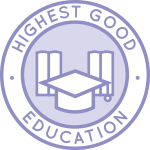 One Community is modeling how to make a difference in the world through Highest Good education that is for all ages, applicable in any environment, adaptable to individual needs, far exceeds traditional education standards, and more fun for both the teachers and the students. This component of One Community is about 95% complete with only the Open Source School Licensing and Ultimate Classroom construction and assembly details remaining to be finished. We’ll report on the final two elements to be finished as we develop them. With over 8 years of work invested in the process, the sections below are all complete until we move onto the property and continue the development and open sourcing process with teachers and students – a development process that is built directly into the structure of the education program and everything else we’re creating too:
One Community is modeling how to make a difference in the world through Highest Good education that is for all ages, applicable in any environment, adaptable to individual needs, far exceeds traditional education standards, and more fun for both the teachers and the students. This component of One Community is about 95% complete with only the Open Source School Licensing and Ultimate Classroom construction and assembly details remaining to be finished. We’ll report on the final two elements to be finished as we develop them. With over 8 years of work invested in the process, the sections below are all complete until we move onto the property and continue the development and open sourcing process with teachers and students – a development process that is built directly into the structure of the education program and everything else we’re creating too:
- Program Overview: Education Open Source Hub
- How the components work together in designing human orchestrated eco-abundance: How to use the Education for Life Program
- Lesson Plans for Life – Lesson Plans How-to
- Foundations of Outstanding Leaders, Teachers, and Communicators
- Curriculum for Life
- Teaching Strategies for Life
- Learning Tools and Toys for Life
- Evaluation and Evolution
This week, Anuneet Kaur (Administrator) contributed to the progress of the Highest Good Education software platform by creating Figma design elements, and enhancing the overall visual layout. She focused on improving the shared navigation bar for both students and teachers, refining it based on Harshitha’s feedback to ensure consistent structure and design. She also explored layout consistency and tested responsive design adjustments for optimal usability. Anuneet researched resources for the most sustainable doors, reviewed scholarly articles, and compiled relevant statistics for the graphics. She ensured all members were included in the live blog task, created and verified new bio announcements, updated the Bio Tracking Spreadsheet, and provided feedback for accuracy. She began drafting content and selecting images for the Highest Good Education Program Licensing and Accreditation webpage, reviewed work from the training team, conducted three interviews, and provided feedback on Yulin’s infographic. She also edited summaries and collages for the Highest Good Society, Highest Good Education, and Core Teams, and reviewed admin submissions for completeness and accuracy. The One Community model of how to make a difference in the world, exemplified by sustainably built classrooms like these, drives sustainable change on a global scale. Her recent contributions are featured in the collage below.
Harshitha Rayapati (Program Manager) continued advancing the Highest Good Education platform by detailing deliverables, developing Figma designs, and expanding the visual layout of the student dashboard. She reviewed and gave feedback on Sphurthy’s breakdown of deliverables into developer-ready tasks and refined the HGN Phase 4 document. Updates to the Teacher Dashboard included adjustments to the navigation bar, inbox layout, and quick action items section. Harshitha also designed a lesson plan form builder and improved the grade submission interface. On the student side, she revised the dashboard timer view and student profile page, creating versions tailored to both young and mature learners for learner support team use. Additionally, she compiled the weekly blog update, reviewed Housing’s progress, edited the blog page, and created a collage. The One Community model of how to make a difference in the world, exemplified by sustainably built classrooms like these, drives sustainable change on a global scale. The collage below highlights her recent contributions.
Ravi Kumar Sripathi (Software Engineer) began contributing to the progress of the Highest Good Education software platform by creating Figma designs and enhancing the overall visual layout. He developed several student-facing components focused on personalization, interactivity, and actionable insights. One key feature is a collaborative interface that helps students convert saved learning atoms and interests into structured weekly lesson plans. This interface uses a four-step, full-screen layout with intelligent autofill from student profiles, a persistent step tracker, and an educator collaboration panel. Ravi implemented dynamic syncing so that when an atom is added to a plan and marked “In Progress” in Knowledge Evolution, it updates to “Planned” and is removed from the saved list, with corresponding changes reflected in the preferred strategies module. He also contributed to the Analytics Dashboard, which presents visualizations such as a subject strengths heatmap, performance trend lines, teaching strategy effectiveness bars, and a life strategy impact chart. Each visualization includes summaries and calls to action, helping students interpret and act on their data. Ravi designed these interface and visual elements with clarity and usability in mind. The One Community model of how to make a difference in the world, exemplified by sustainably built classrooms like these, drives lasting global change. Take a look at the following images related to his work.
HIGHEST GOOD SOCIETY PROGRESS
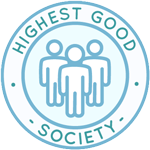 One Community is modeling how to make a difference in the world through a Highest Good society approach to living that is founded on fulfilled living, the study of meeting human needs, Community, and making a difference in the world:
One Community is modeling how to make a difference in the world through a Highest Good society approach to living that is founded on fulfilled living, the study of meeting human needs, Community, and making a difference in the world:
- Read the Highest Good society overview: Highest Good Society
- Learn about the model for fulfilled living and sharing: A Day in the Life
- Learn about the 4 economic models: RBE | For-profit | Non-profit | Entrepreneurship
- Learn about our open source community collaboration and management software: The Highest Good Network
This week, the core team completed over 57 hours managing additional volunteer work reviews not listed here, handling emails, overseeing social media accounts, supporting web development, identifying new bugs, integrating bug fixes for the Highest Good Network software, and interviewing and onboarding new volunteer team members. They also produced and incorporated the video above, which illustrates how to make a difference in the world forms the foundation of One Community’s broader mission. The image below highlights some of this work.
Govind Sajithkumar (Project Manager) continued focusing on analytics and content management for Meta’s Facebook and Instagram platforms.He managed the weekly social media content rotation by preparing, scheduling, and uploading new posts to both platforms and updated the Open Source spreadsheet with the latest content details. Govind refreshed the social media analytics spreadsheet with current performance metrics, audience demographics, and engagement statistics. In addition, he led the PR Review Team by providing feedback on team members’ documents, updating the WordPress site with the weekly team summary and collage, and maintaining the PR Review Team Table and HGN PR spreadsheet. He also submitted his admin feedback table, supporting One Community’s efforts in how to make a difference in the world. The images below highlight key aspects of this work.
Jaiwanth Reddy Adavalli (Project Manager) continued developing the Job Applicants page along with key components of the Highest Good Network Phase 2 and Phase 4 dashboards, including the PR Team analytics section. He tested several pull requests in the software and progressed on the PR Review Team Analytics dashboard. Jaiwanth updated action items for the related Figma wireframes and managed task creation by monitoring software team management documents, following up on task progress. As a PR Review Team member, he reviewed pull requests from assigned volunteers. This project plays a vital role in One Community’s commitment to how to make a difference in the world. The images below highlight his contributions from this week.
ADMINISTRATION TEAM
The Administration Team summary, covering their work administrating and managing most of One Community’s ongoing process for how to make a difference in the world was managed by Bhakti Tigdi (Project Manager) and includes Harsha Ramanathan (Administrator), Himanshu Mandloi (Engineering Project Manager), Khushie Zaveri (Communication Strategist), Neeharika Kamireddy (Data Analyst), Olawunmi “Ola” Ijisesan (Administrative and Management Support), Olimpia Borgohain (Data Analyst and Team Administrator), Rachna Malav (Data Analyst), Rajeshwari Bhirud (Administrator), Rishi Sundara (Quality Control Engineer and Team Administrator), Rishitha Adepu (Administrator), and Samhitha Are (Administrator). The Highest Good Network software is how we’ll be managing and objectively measuring our process for how to make a difference in the world through our social architecture, construction, production, and maintenance processes.
This week, the Administration team supported diverse operations, including project coordination, technical reviews, platform management, and content development. Harsha expanded sustainability research, focusing on materials for toilets, faucets, flooring, and adhesives. Collaborating with Yulin, Harsha revisited prior feedback to improve data accuracy and structure. Himanshu maintained admin momentum by handling daily TimeLog reviews, resolving task issues, and providing updates to keep progress on track. He also created a blog aligned with One Community’s open-source mission. Khushie led the social media campaign launch, coordinated scheduled posts, and assisted admin trainees with workflow and documentation questions, reinforcing One Community’s commitment to how to make a difference in the world.
Neeharika assigned tasks within the software team, monitored PR progress, and tested pull requests while overseeing a new admin’s work. Ola addressed an accessibility issue, ensured proper workspace setup for the admin team, and submitted progress reports and images. Olimpia scheduled daily LinkedIn posts, reviewed volunteer submissions, and managed ongoing blog development. Rachna handled email follow-ups, scheduled candidate interviews, and contributed to SEO research. This work supports One Community’s plan for how to make a difference in the world. Rajeshwari completed her training and led onboarding for five volunteers, managing summaries, images, and blog content. Rishi tested pull requests, merged blog content, and conducted quality checks on training materials. Rishitha finalized admin onboarding and began roles on the Hiring and Social Media teams. Samhitha completed and revised blog content, assisted with training reviews, and studied Jae’s video tutorials to improve task management. This work contributes to One Community’s commitment to how to make a difference in the world. See below to view images of their work.
GRAPHIC DESIGN TEAM
The Graphic Design Team’s summary includes Yulin Li (Graphic Designer), Qinyi Liu (Graphic Designer), and Rutal Deshmukh (Graphic Designer), who focused this week on creating graphic designs that support how to make a difference in the world. Qinyi revised Week 3 posters, updated character designs, and created new visuals featuring speech bubbles. She also refreshed Gopika Lakshmi’s bio and website content using authentic images to highlight how to make a difference in the world. Rutal developed social media graphics, updated a bio announcement following Sara’s approval, and received new assignments from Shivangi via document comments. Yulin contributed by revising visuals based on feedback and finalizing sustainability-themed posters. See the Highest Good Society pages for more on how this contributes to how to make a difference in the world. The collage below showcases examples of their work.
HIGHEST GOOD NETWORK PROGRESS
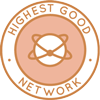 One Community is modeling how to make a difference in the world through open source Highest Good Network® software that is a web-based application for collaboration, time tracking, and objective data collection. The purpose of the Highest Good Network is to provide software for internal operations and external cooperation. It is being designed for global use in support of the different countries and communities replicating the One Community sustainable village models and related components.
One Community is modeling how to make a difference in the world through open source Highest Good Network® software that is a web-based application for collaboration, time tracking, and objective data collection. The purpose of the Highest Good Network is to provide software for internal operations and external cooperation. It is being designed for global use in support of the different countries and communities replicating the One Community sustainable village models and related components.
- Learn about our open source community collaboration and management software: The Highest Good Network
This week, the core team continued working on the Highest Good Network software pull requests and resolved several key issues. Fixes included conflict resolution and requested changes for pending PRs, updating the default setting in the User Management table to show 20 rows per page, correcting UI display problems on the Send Emails page, and fixing dropdown menu errors under Other Links for Manager accounts. Additional updates addressed issues with bell notifications, the blue square chart, and link-type limitations, along with UI problems that were preventing new tasks from being added or causing visual breakages.
Some tasks remain unresolved, including the Job Posting Application Age bar chart, the FAQ tool implementation, and several hotfixes. Beyond development, the team assigned new tasks to volunteers, reported bugs related to updating Start Dates, logged new FAQ questions, flagged Profile Page misalignment issues with End Date and Status, and maintained team communication on Slack. See the Highest Good Society and Highest Good Network pages for more on how this aligns with One Community’s commitment to how to make a difference in the world. The collage below highlights some of this work.
ALPHA SOFTWARE DEVELOPMENT TEAM
This week, The Alpha Software Team, covering their progress on the Highest Good Network software, was managed by Lin Khant Htel (Frontend Software Developer) and Carlos Martinez (Full-Stack Software Developer), and Nikita Kolla (Full Stack Developer). This software is an internal management and communication platform with the goal of How to Make a Difference in the World. This week’s summary was managed by Lin and Carlos. Lin reviewed and approved PR #1537, tested the changes locally to ensure all test cases passed, consulted with team members, reviewed and verified weekly summaries, photos, and videos submitted by Alpha team members, and performed overall management responsibilities for the team. This work advances One Community’s focus on how to make a difference in the world. Carlos addressed a bug related to adding blue squares and ensured the assigned date is automatically included in blue square summaries. A new input component was added to the form, which now includes a read-only field displaying the logged-in user’s name and the assigned date in MM/DD/YY format to meet functional requirements. Nikita continued work on the task “core team member’s additional hours” should be processed properly. She added more tests to verify the calculation of additional hours and the display of blue squares, prepared the code for the pull request, and reviewed related logic to ensure consistency across affected components. See the Highest Good Society and Highest Good Network pages to learn more on how this relates to how to make a difference in the world. See some of the team’s work in the collage below.
BINARY BRIGADE SOFTWARE DEVELOPMENT TEAM
The Binary Brigade Team’s summary highlights the contributions of team members Amalesh Arivanan (Software Engineer), Nikhil Routh (Software Engineer), Ramsundar Konety Govindarajan (Software Engineer), and Taariq Mansurie (Full-Stack Developer). The Highest Good Network software is how we’ll be managing and objectively measuring our process for how to make a difference in the world, ensuring that all contributions are effectively tracked and aligned with our mission.
This week, Amalesh worked on fixing the issue with displaying the “Contributors Report,” related to pull request 3423. The problem involved the report not being generated when clicking the “Show Contributors Report” button on the Dashboard under Reports. He implemented a fix for this issue and created pull request 3787 with the changes. The work was tested and documented with screenshots and videos, which were uploaded to the shared Dropbox folder using the required naming conventions. Time spent was tracked using the HGN timer, and onboarding steps were completed to maintain access to project tools and documentation. This work supports One Community’s dedication to how to make a difference in the world. Nikhil worked on migrating legacy CSS files to the CSS Modules format. This involved converting .css files to .module.css and making necessary updates to JSX files, including changes to import statements and className attributes to reference the styles object. He also worked on the fixes of PR 3770 and PR 3773 concerning the timelog and weekly summary reports after reviews and resolved merge conflicts, and updated the PRs. Ram worked on investigating the bug related to the ‘X’ button on the dashboard under task names, which allows task deletion. The issue was that while the Owner account could delete tasks, users with the “Interact with Task” permission could not. This effort reflects One Community’s focus on how to make a difference in the world. He initially reviewed an older fix that unintentionally gave volunteers with the “Interact with Task” role the ability to delete tasks, which was not the intended behavior. While analyzing this, he checked the permissions constants file and confirmed that the backend logic was functioning as expected. He found that the permissions were being passed correctly, but there was a mismatch between what the frontend validated and what the backend accepted. Since the original fix PR 3497 was from over three months ago, he suspected the current development branch may have changed significantly. After switching to the latest development branch and retesting, he found that the delete option was no longer visible to users with only the “Interact with Task” role. Based on this, he decided not to apply any new fix and instead pinged Jae to confirm the expected behavior. This contribution aligns with One Community’s mission on how to make a difference in the world.
Taariq focused on resolving multiple issues related to the Weekly Summaries Reports Page and the Node version upgrade. This work furthers One Community’s pursuit of how to make a difference in the world. He fixed the filters bug on refresh by storing the selection in the browser and continued working on the Select All functionality for individual user filterColor selections based on new requirements discussed with Jae. He worked on removing inactive users from the Weekly Summaries Reports Page, addressed npm version conflicts, and resolved failing test cases in his branch to ensure it could be merged into the development branch. He also helped Jae solve merge conflicts for a separate backend pull request and pushed updates for the Node lint fixes after resolving several merge conflicts. See the Highest Good Society and Highest Good Network pages for more, and the collage below for images of their work. This contribution is part of One Community’s strategy for how to make a difference in the world.
BLUE STEEL SOFTWARE DEVELOPMENT TEAM
The Blue Steel Team’s summary, presenting their work on the Highest Good Network software, was managed by Sheetal Mangate (Software Engineer) and includes Humemah Khalid (Software Engineer/Backend Developer), Linh Huynh (Software Engineer), and Ramakrishna Aruva (Software Engineer). The Highest Good Network software is how we’ll be managing and objectively measuring our process for how to make a difference in the world, ensuring that all contributions are effectively tracked and aligned with our mission.
This week, Humemah updated the database and frontend to store blue square infringement reasons and fixed a bug where deactivated managers were still receiving notifications. Linh resolved bugs and merge conflicts in the Blogger auto-poster, addressing API and token issues on the backend and adjusting routing, components, and formatting on the frontend. She also restructured the branch, verified code using tests, and ensured CI/CD compatibility. Ramakrishna fixed a crash in the “Add Lost Time” modal by adding error handling and passing required props, restoring functionality for teams and projects. Sheetal created a backend endpoint and resolved a URL error affecting a POST request. She began implementing backend token handling for Reddit, with a fallback plan if needed. This collective work supports One Community’s strategy for how to make a difference in the world. See the Highest Good Society and Highest Good Network pages for more, and the collage below for images of their work.
CODE CRAFTERS SOFTWARE DEVELOPMENT TEAM
The Code Crafters Team, covering their work on the Highest Good Network software, was managed by Sai Moola (Software Engineer) and includes Ajay Naidu (Software Engineer), Ashrita Cherlapally (Software Engineer), Greeshma Palanki (Software Engineer), Humera Naaz (MERN developer), Juhitha Reddy Penumalli (Software Engineer), Sphurthy Satish (Software Engineer), and Sundar Machani (Software Engineer). The Highest Good Network software is how we’ll manage and objectively measure our process for establishing abundant community systems through our social architecture, construction, production, and maintenance processes, and support widespread and lasting eco-lifestyle access.
This week, Ajay updated the List of Teams page with filters for Active and Inactive teams, added messaging for empty search results, and investigated a pie chart display bug using test data. Ashrita created backend APIs to aggregate applicant data by country, added filters, seeded test data, and began rendering a world map with tooltips and color scaling—supporting open data tools for how to make a difference in the world. Greeshma resolved a blank page error related to inactive user handling and fixed a Node.js version mismatch to restore platform stability, ensuring consistent participation from those learning how to make a difference in the world.
Humera worked on PR #3439, tracing issues that prevented the site from loading, checking backend routing, and validating her environment setup. Juhitha fixed inventory type bugs, added support for units of measurement, and began building a reusable backend controller—all supporting smoother workflows for those contributing to how to make a difference in the world. Sai integrated react-select into a chart, synced backend and frontend data, and fixed CI conflicts—helping maintain a reliable system that supports how to make a difference in the world. Sphurthy outlined backend and frontend needs for student workflows, journaling, badge tracking, and analytics as part of Phase 4 of the Highest Good Education platform. Sundar completed the Node.js 20 upgrade, resolved remaining lint issues, merged team contributions, and passed all CI checks to finalize the upgrade. These efforts contribute to stable infrastructure and educational tools designed to teach people how to make a difference in the world. See the Highest Good Society and Highest Good Network pages for more on how this relates to how to make a difference in the world. View some of the team’s work in the collage below.
DEV DYNASTY SOFTWARE DEVELOPMENT TEAM
The Dev Dynasty Team’s summary, covering their work on the Highest Good Network software, was managed by Zhifan Jia (Software Engineer) and includes Adithya Cherukuri (Volunteer Software Engineer), Deekshith Kumar Singirikonda (Developer), Dharmik Patel (Software Engineer), Manvitha Yeeli (Software Engineer), Mohan Satya Ram Sara (Software Engineer), Neeraj Kondaveeti (Software Engineer), Prasanth Bhimana (Software Engineer), Saicharan Reddy Kotha (Software Engineer), Shraddha Shahari (Software Engineer), Vamsi Krishna Rolla (Software Engineer), Vamsidhar Panithi (Software Engineer), and Varsha Karanam (Software Engineer). The Highest Good Network software is how we’ll manage and objectively measure our process for establishing abundant community systems through our social architecture, construction, production, and maintenance processes to support widespread and lasting eco-lifestyle access. This effort exemplifies One Community’s vision for how to make a difference in the world.
This week, Adithya began building a horizontal bar chart to show average pledged months by role, using backend APIs and sample data to troubleshoot visual issues—enhancing understanding of how to make a difference in the world through team commitments. Deekshith implemented a secure backend registration API for the Listing and Bidding dashboard, adding validation and password hashing to support trustworthy user participation. Dharmik added protected routes to the PR Review Team Analytics Dashboard and resolved Node.js build and CI test issues—supporting reliable deployment of tools that guide people in how to make a difference in the world. Manvitha fixed bio status update bugs, merged related PRs, and adjusted dark mode styling to stabilize the user interface. Mohan improved the login experience by addressing timezone issues, refactoring theme toggling, and enhancing accessibility—all key to inclusive systems supporting how to make a difference in the world.
Neeraj reviewed PRs, bid on new tasks, and tested backend APIs while documenting results. Prasanth audited Phase 2 documentation, flagged issues, and worked with Sai Charan and Varsha to align UI/UX and implementation. Saicharan coordinated Phase 2 follow-ups, reviewed PRs, and helped log key updates, all contributing to shared clarity around how to make a difference in the world. Shraddha resolved merge conflicts and completed dark mode UI fixes while cleaning older PRs for efficiency. Varsha cross-checked implementation against documentation, flagged gaps, and followed up with action items. Vamsi finalized a chart to visualize tool usage and downtime, improving responsiveness and data clarity. Vamsidhar worked on frontend and backend for the Tool/Equipment History log, resolving routing and integration issues to ensure accurate reporting. Zhifan wrapped up a previous PR and began building a backend analytics page with privacy-conscious tracking and admin endpoints—offering data insights into how to make a difference in the world through informed decisions. See the Highest Good Society and Highest Good Network pages for more on how this relates to how to make a difference in the world. View some of the team’s work in the collage below.
EXPRESSERS SOFTWARE DEVELOPMENT TEAM
The Expressers Team’s summary, which covers their work on the Highest Good Network, was managed by Strallia Chao (Software Engineer) and includes Casstiel Pi (Software Engineer), Meenashi Jeyanthinatha (Full Stack Developer), Rahul Trivedi (Software Engineer), Reina Takahara (Software Developer), and Tanmay Arora (Software Engineer). The Highest Good Network software helps us manage and objectively measure our progress toward how to make a difference in the world through innovative software development, testing, and collaboration. This week, Casstiel continued to work on the auto-poster feature for the platform Plurk. He encountered a 401 status code error, indicating a possible authentication issue. To troubleshoot, he reviewed the API documentation and attempted to resolve the issue by storing the auth_token, but the error persisted. As a next step, he plans to use Postman to test the API calls outside the local development environment. Meenashi reviewed comments on the HGN Questionnaire PR and incorporated them into the basic validation for the MERN work experience input. This work advances One Community’s focus on how to make a difference in the world. She resolved merge conflicts for the PR titled “Sanjeevkumar – Added APIs for financial summary of the Building Projects” and pushed the changes, followed by a new PR with test instructions and screenshots. Most data matched, except for the mom-changes API which requires further review. This contribution is part of One Community’s strategy for how to make a difference in the world. She also created a local branch titled “Anjali – Phase 3 – Optimize Follow-Up Email Templates and Feedback Form” to add star rating validation and shared a demo video with Jae. Additionally, she investigated the HGN Questionnaire PR issue where testers could not view volunteer details. Using Postman, she confirmed that under current conditions, volunteers cannot view other users’ details. Clarification was requested to determine if testers were accessing their own or other profiles. Lastly, she began investigating the “Application Page: Category” to document current behavior and confirm expected changes. This contribution reinforces One Community’s commitment to how to make a difference in the world.
Rahul adjusted the PR graph to support dark mode and added additional mock data to enhance presentation. He completed and merged the Top 20 PRs graph into the development branch (PR 3746) after implementing all feedback provided by the PR Review team. He also reviewed documentation related to the Manager position offered by Jae and Strallia, identified new development tasks, and began replicating a navbar alignment issue on his local setup. This work plays a role in One Community’s plan for how to make a difference in the world. Reina worked on the “Create Line Graph Chart for Cost Breakdown by Expenditure” task by addressing test failures and resolving layout padding issues. She also worked on the questionnaire dashboard by fixing zero value feedback, permission problems, and implementing layout and backend updates. Time was also spent resolving a local terminal issue blocking progress. Strallia updated the backend of the Blue Square Stats chart on the Total Org Summary page to use a new database field for accurate data, submitted in PR 1553. This effort contributes to One Community’s mission on how to make a difference in the world. She then updated the corresponding frontend by removing the no-data-available screen and correcting the comparison percentage calculation using backend data, submitted in PR 3784. She also attempted to fix merge conflicts during the latest merge from the dev branch to main, submitted as PR 1585. This work embodies One Community’s strategy for how to make a difference in the world. Tanmay worked on restoring an update notification popup in a React-based app to inform users of new updates when development changes are merged into the main branch. Initially, the popup logic used version string comparison. After feedback, it was updated to check against a fetched hash.txt file. The component was built using React and CSS, integrated with App.js, and supported local testing instructions using either hash editing or clearing local storage. See the Highest Good Society and Highest Good Network pages for more on how this contributed to how to make a difference in the world. See the collage below to view the team’s work.
LUCKY STAR SOFTWARE DEVELOPMENT TEAM
The Lucky Star Team’s summary, which covers their work on the Highest Good Network, was managed by Barnaboss Puli (Volunteer Software Engineer) and includes contributions from Dipti Yadav (Software Engineer), Durga Venkata Praveen Boppana (Software Engineer), Ganesh Karnati (Software Engineer), Kedarnath Ravi Shankar Gubbi (Software Engineer), Manoj Gembali (Software Engineer), Pranav Govindaswamy (Software Developer), Shashank Madan (Software Engineer), Veda Bellam (Software Engineer), and Venkataramanan Venkateswaran (Software Engineer). Their work continued to support our goal of how to make a difference in the world through collaborative and cross-functional software development.
This week, Barnaboss contributed to the HGN Phase 2 “Fix Project Details” task. He implemented tag input with support for the enter key, enabled auto-tagging based on context or URL, and added a role-based visibility dropdown with validation and tooltips. He also built the POST endpoint to submit lesson data, connected the form to the backend, tested edge cases, and made progress on the auto-poster for Twitter/X. This work embodies One Community’s strategy for how to make a difference in the world. Additionally, he debugged the deadline tracking feature using network tools and revised related code. Dipti addressed two interface issues: aligning the red circular icon and adjusting font color and alignment for the Role “i” icon popup in dark mode on the Permissions Management page. This activity supports One Community’s pursuit of how to make a difference in the world. She submitted both changes in separate PRs (#3794 and #3806), each with documentation, video demonstrations, and screenshots. Durga resolved merge conflicts while merging with the development branch and fixed a priority issue on the reports page where font colors were not visible in dark mode. The changes were implemented, tested, and merged. Ganesh developed the backend for the Weekly PR Grading feature. He created route files, integrated MongoDB with Mongoose, defined schemas, added validation logic, and developed controller functions to handle submissions, duplicate checks, and grading retrievals. All endpoints were tested using Postman, and the backend was structured to support future frontend integration. This work supports One Community’s dedication to how to make a difference in the world.
Kedarnath implemented the “What We Do” section on the Job Application Listing page. He added clickable icons for each Highest Good component with short 3–4 line descriptions to improve clarity and user navigation. Manoj worked on the dropdown modal for PR grading. He implemented dark mode support, layout responsiveness, and logic for the grade-saving handler. He also developed additional mock data and a utility page for PR team testing. This effort reflects One Community’s focus on how to make a difference in the world. Pranav implemented the backend logic for a donut chart showing applicants by experience. He refined MongoDB aggregation queries using $dateFromString and $expr, added role-based filtering, and ensured proper handling of empty datasets. A new PR (#1606) was submitted with screenshots of updated results. This contribution aligns with One Community’s mission on how to make a difference in the world. Shashank analyzed a white screen loading issue by adding logs, reviewing the code flow, and improving error handling. He explored the root cause using API logging and experimented with useMemo and debounce to enhance performance. Veda worked on the Job Posting Page Analytics feature. She resolved a backend route mismatch causing a 404 error, integrated the frontend with backend endpoints, and improved the UI by adding filters, refining overlapping labels, and supporting year selection in the date picker. Venkataramanan resolved a complex merge conflict involving frontend and backend code (PR #3774) and submitted PR #3791 with additional fixes. His efforts ensured development stability and supported team collaboration. See the Highest Good Society and Highest Good Network pages to learn more about how this work supports how to make a difference in the world. See the collage below to view the team’s work.
MOONFALL SOFTWARE DEVELOPMENT TEAM
The Moonfall Team’s summary, which covers their work on the Highest Good Network, was managed by Rishitha Adepu (Software Administrator), and includes Shashank Kumar (Software Engineer), Aayush Jayant Shetty (Software Engineer), Alisha Walunj (Software Engineer), Sai Krishna (Software Engineer). This week, Sai Krishna reviewed eight pull requests, including PRs 1555, 3605, 3607, 3709, 3773, 3782, 3787, and 3790. This work furthers One Community’s pursuit of how to make a difference in the world. In PR 1555, he identified that the GET API for promotions was functioning as expected, but the POST API was accepting requests both with and without requester details, prompting a request for changes. In PR 3605, he noted that the dropdown was not overlapping with the “taking time off” content on various screen sizes. In PR 3607, he confirmed that user screens were rendering correctly in mobile view. He reviewed the remaining pull requests for code quality, functionality, and adherence to project standards. He also updated the “PR Review Team Dashboard” document, communicated with developers about the pull requests, updated comments, reviewed merged pull requests in the development environment, and tested open pull requests locally, requesting changes where needed. This work furthers One Community’s pursuit of how to make a difference in the world. Aayush worked on the HGN Software Team Questionnaire and PR Team Admin Dashboard Action Item Checking and Identification task. He reviewed documentation to track merged pull requests, updated action items accordingly, added a summary to reflect the changes, verified the functionality of several pull requests, and updated statuses where required. He contacted contributors when issues were found and reviewed the team’s review and tracking processes to improve his understanding. This activity highlights One Community’s approach to how to make a difference in the world.
Alisha worked on the task “Job Posting Page Analytics: Create a pie chart showing breakdown of applicants by reason of volunteering” by populating initial data into the database and resolving an issue where applying multiple role filters led to data errors. She adjusted the code to handle filtering by one role at a time and corrected an issue where the pie chart labels were displaying repeated colors. She also fixed a routing issue, addressed linting errors, reviewed the backend for the “Phase 2 Summary Dashboard: Create a Loss Tracking Line Graph,” and began working on comments left from earlier stages of development. Her work contributes to the team’s broader effort to understand how to make a difference in the world through improved functionality and data insights. Shashank worked on resolving an error in the BM Dashboard issue log by identifying the root cause related to incorrect routing and form validation. He implemented proper routes, added a missing button to the UI to align with expected user actions, and fixed issues that were causing the form to throw errors during submission. In addition to this, he collaborated with other developers to help them troubleshoot bugs in their tasks, offering suggestions and solutions to unblock their progress. He also assisted a team member in navigating internal processes to gain access to management training, ensuring they had the necessary information and support to proceed. His contributions this week aligned with the team’s goal of exploring how to make a difference in the world by improving team efficiency and system stability. Shown below are some photos highlighting this work.
REACTONAUTS SOFTWARE DEVELOPMENT TEAM
The Reactonauts Team’s summary, covering their work on the Highest Good Network was managed by Olimpia Borgohain (Data Analyst and Team Admin) and Akshay Jayaram (Software Engineer). The team includes Fatima Villena (Software Engineer), Ghazi Rahman Shaik (Software Engineer Intern), Jaydeep Mulani (Software Developer), Kristin Dingchuan Hu (Software Engineer), Peterson Rodrigues dos Santos (Full Stack Developer), Rishwa Patel (Software Developer), and Siva Putti (Software Engineer). The Highest Good Network software helps manage and objectively continue to support by focusing on how to make a difference in the world, social architecture, construction, production, and maintenance processes to build sustainable and thriving ecosystems. This solution is portable, scalable, and ideal for off-grid or sustainable living communities.
This week, Akshay completed the layout collapse task on the PeopleReport page and opened PR #3802, modifying CSS media queries to adjust when the profile component switches from side-by-side to stacked layout. He worked on how to make a difference in the world and also updated component structures to improve layout behavior and coordinated Reactonauts team activities by tracking pull requests and submitting the weekly review. Fatima worked on the frontend of the PR Dashboard for the Highest Good Network App, finishing the Promotion Eligibility table by integrating backend data, finalizing the table structure, applying design updates, adding action buttons, and implementing eligibility logic, with all changes committed to a new branch and submitted as a pull request. This activity highlights One Community’s approach to how to make a difference in the world. Ghazi improved task assignment in the HGN Software Development project by refactoring the TagsSearch and AddTaskModal components to use a preloaded allMembers dataset, enhanced user suggestions by excluding assigned users, fixed data inconsistencies between different member fields, resolved a blocking test, added debugging logs, and addressed merge conflicts tied to the default password PR. Jaydeep restored two automated email features in the HGN Software Development project: one for the Weekly Summaries Report and another for the blue square email order. For the first, he replaced a failed PR by creating a new branch and resubmitting changes. For the second, he identified and fixed a database issue and raised a separate PR after documenting concerns about hardcoded recipients in the existing logic. This contribution is part of One Community’s strategy for how to make a difference in the world.
Kristin investigated a login issue reported by two developers, analyzing four error messages and determining that one fix could involve moving the service worker file to the public folder, while other errors were likely caused by Chrome extensions. She contacted the affected users for more information and installed related extensions to replicate the issue. This effort exemplifies One Community’s vision for how to make a difference in the world. Peterson fixed two bugs on the Projects page involving search input behavior: the first prevented the table from showing matching results, and the second caused an error after clearing the input. This contribution aligns with One Community’s mission on how to make a difference in the world. Rishwa worked on the Help Community Dashboard by implementing dynamic filtering and rendering logic for Skill Cards, replacing hardcoded structures with reusable logic to filter skill submissions and map them to RankedUserCards, also ensuring compatibility with radar chart data and future filtering features. Siva addressed requested changes for a pull request improving the Create New Team flow under Team Management to align with the existing team creation flow, and resolved an issue where the Select Team dropdown was being obscured by the vacation mode overlay, updating both pull requests with the necessary changes. See below for the work done on how to make a difference in the world done by the team.
SKYE SOFTWARE DEVELOPMENT TEAM
Skye Team’s summary, covering their work on the Highest Good Network was managed by Olimpia Borgohain (Data Analyst and Team Admin) and Anthony Weathers (Software Engineer). The team includes Gopikalakshmi Asok Kumar (Software Developer), Julia Ha (Software Engineer), and Marcus Yi (Software Engineer). The Highest Good Network software helps manage and objectively continue to support by focusing on how to make a difference in the world, construction, production, and maintenance processes to build sustainable and thriving ecosystems. This solution is portable, scalable, and ideal for off-grid or sustainable living communities.
This week, Anthony continued his work on how to make a difference in the world, frontend PR#3121 and backend PR#1216. He reached out for assistance and researched possible fixes, but the issue remained unresolved. He also reviewed backend PR#1599 at Jae’s request, manually tested the weekly summary email functionality. He approved PR as it addressed partial errors with the emailSender used for emailing the weekly summaries. This work supports One Community’s dedication to how to make a difference in the world. Gopika worked on the “Bell notification for meetings” feature (3374), attempted to update the code with the development branch but encountered issues that delayed progress. After resolving the conflicts, she completed the setup, which allowed users to create meetings and see upcoming meetings for the next three days on the homepage. She worked on addressing an issue with closing the notification button by updating the database field isRead to true, but encountered a 401 authentication error that blocked that update and troubleshooted it. This project underlines One Community’s dedication to how to make a difference in the world.
Julia focused on building the backend API to retrieve the most popular pull requests from GitHub, created the endpoint at /api/analytics/popular-prs, and implemented logic to parse the duration parameter to return the correct date range for data aggregation. This work advances One Community’s focus on how to make a difference in the world. She created three database models: PullRequest, PullRequestReview, and PullRequestSyncMetadata and developed helper functions to fetch data from the GitHub API, including pagination handling. She also implemented a cron job to pull updates from GitHub and synchronize the local database to support on-demand aggregation when the API endpoint is called. Marcus began work on the OnlyWire replacement project by creating a document compiling prior pull requests from the original implementation and reviewing each to assess which could be reused for the new version. Progress on this effort was paused to address merge conflicts between the development repository and the main branch. See below for the work done on how to make a difference in the world by the team.
SOFTWARE PR REVIEW TEAM A-F
This week, the PR Review Team’s summary for members with names starting A–F, managed by Neeharika Kamireddy (Data Analyst), highlights their contributions to the Highest Good Network software. This platform forms the foundation for measuring our results in modeling how to make a difference in the world. Active team members included Abdelmounaim Lallouache (Software Developer), Benitha Sri Panchagiri (Software Engineer), Carl Bebli (Software Developer), and Chaitanya Swaroop Kumar Allu (Software Engineer). They supported the project by thoroughly reviewing all pull requests shared this week. Learn more about how the Highest Good Network tracks progress toward modeling how to make a difference in the world in the Highest Good Network open source hub. The collage below showcases a compilation of this team’s work.
SOFTWARE PR REVIEW TEAM G-N
This week, the PR Review Team’s summary for team members with names starting from G–N, covering their work on the Highest Good Network software, was managed by Govind Sajithkumar (Software Project Manager). The Highest Good Network software is a foundation for measuring our results in modeling how to make a difference in the world. Active team members included Guna Pranith Reddy Cheelam (Developer), Gurusai Chittoji (Software Engineer), Harsha Rudhraraju (Software Engineer), Harika Majji (Software Engineer), Kurtis Ivey (Full Stack Developer), Manvi Kishore (Software Engineer), Nahiyan Ahmed (Full Stack Software Developer), and Nathan Hoffman (Software Engineer). They reviewed all the Highest Good Network pull requests shared in this week’s update. Learn more about how the Highest Good Network measures progress in modeling how to make a difference in the world by exploring the Highest Good Network open-source hub. Shown below are some photos highlighting the work from this team.
SOFTWARE PR REVIEW TEAM O-Z
This week, the PR Review Team’s summary for team members with names starting from O–Z, covering their work on the Highest Good Network software, was managed by Jaiwanth Reddy Adavalli (Software Project Manager). The Highest Good Network software is a foundation for measuring our results in modeling how to make a difference in the world. This week’s active team members included Marneni Shashank (Software Engineer), Rishitha Chirumamilla (Software Engineer), Rohit Mamidi (Software Engineer), Rohith Mallipudi (Software Engineer), Sankar Sai (Software Engineer), Shravya Kudlu (Software Development Engineer), Sohail Uddin Syed (Software Engineer), Sreeja Nandyala (Software Engineer), Siri Sudheeksha Vavila (Software Engineer), Suparshwa Patil (Software Engineer), and Uha Kruthi (Software Engineer). They reviewed all the Highest Good Network pull requests shared in this week’s update. Learn more about how the Highest Good Network measures progress in modeling how to make a difference in the world by exploring the Highest Good Network open-source hub. The collage below shows a compilation of the work from this team.
AND WE PRODUCED THIS WEEKLY UPDATES BLOG – CLICK HERE TO SUBSCRIBE
FOLLOW ONE COMMUNITY’S PROGRESS (click icons for our pages)
INVESTOR PAGES
GET INVOLVED
DONATE | WAYS ANYONE CAN HELP | MEMBERSHIP
CLICK HERE FOR ALL PAST UPDATES
 One Community
One Community